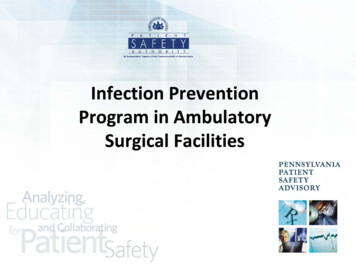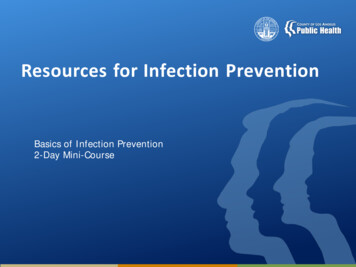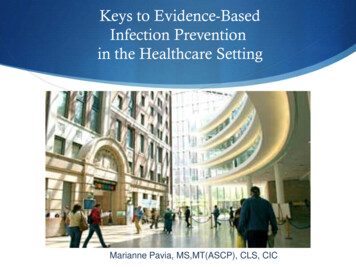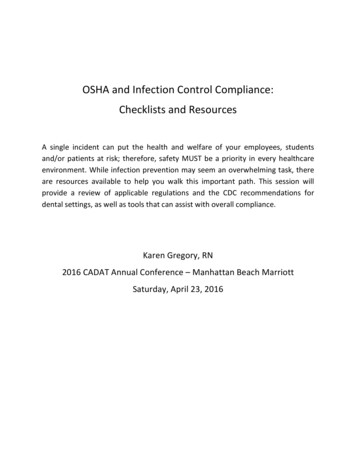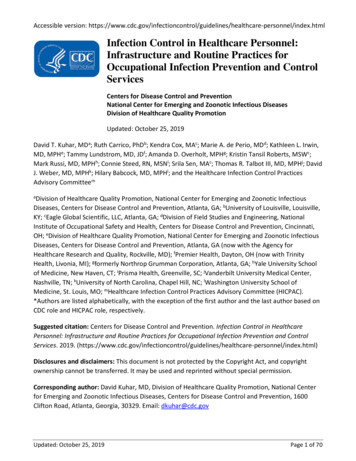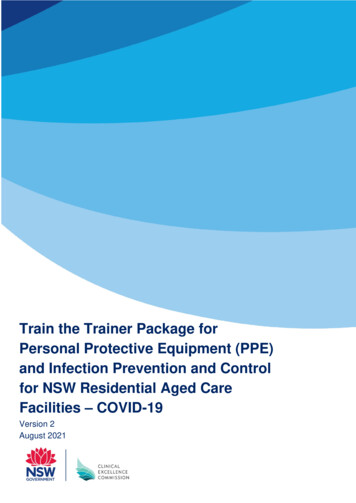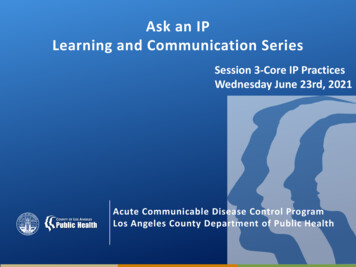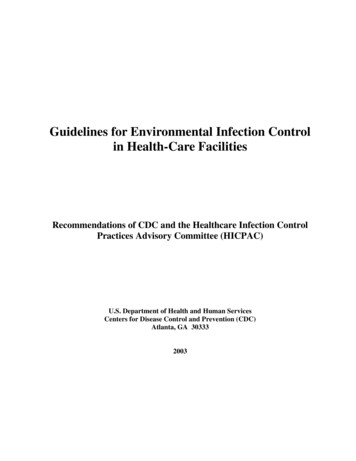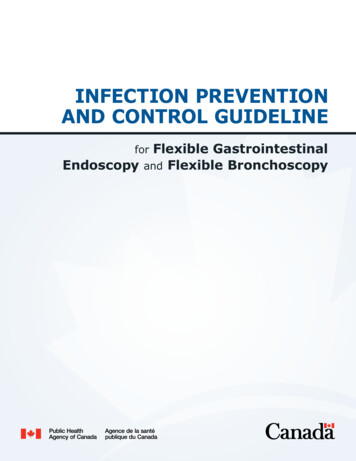
Transcription
INFECTION PREVENTIONAND CONTROL GUIDELINEFlexible GastrointestinalEndoscopy and Flexible Bronchoscopyfor
To promote and protect the health of Canadians through leadership, partnership,innovation and action in public health.— Public Health Agency of CanadaInfection Prevention and Control Guideline for Flexible Gastrointestinal Endoscopy and Flexible Bronchoscopyis available on Internet at the following address: http://www.phac-aspc.gc.caÉgalement disponible en français sous le titre :Lignes directrices pour la prévention et le contrôle des infections transmises par les appareils souplesd'endoscopie digestive et de bronchoscopie.This publication can be made available in alternative formats upon request. Her Majesty the Queen in Right of Canada, 2010Cat.: HP40-55/2010E-PDFISBN: 978-1-100-17223-1
Table of ContentsIntroductory Statement. 5Executive Summary . 8PART I. PURPOSE . 11PART II. TRANSMISSION OF INFECTION BY FLEXIBLE ENDOSCOPY . 121. Background . 121.1. Spaulding Classification for Medical Devices. 122. Overview. 123. Microbial Sources . 133.1.Endogenous. 133.2.Exogenous. 144. Specific Microorganisms Transmitted or Shown to Contaminate Flexible Endoscopes. 165. Occupational Infection Related to Endoscopy. 196. Classic and Variant Creutzfeldt-Jakob Disease . 207. Factors That Contribute to Survival of Microorganisms in Reprocessed Flexible Endoscopes. 217.1.Wet Storage. 217.2.Biofilm Formation and Organic Debris . 227.3.Equipment Design Flaws . 228. Errors in Reprocessing. 22PART III. FLEXIBLE ENDOSCOPES: STRUCTURE and FUNCTION . 24PART IV. ISSUES RELATED TO REPROCESSING FLEXIBLE ENDOSCOPES . 291. Reprocessing of Flexible Endoscopes and Accessories. 291.1.Pre-Cleaning . 351.2.Leak Test. 351.3.Manual Cleaning and Rinsing. 361.4.Disinfection and Sterilization . 371.4.1.Selection of a High Level Disinfectant Product . 381.4.2.Liquid Chemical Agents . 381.4.3.Low Temperature Gas and Gas Plasma Sterilization . 391.4.4.Automated Endoscope Reprocessors (AERs). 441.4.5.Reprocessing Endoscopic Accessories . 451.4.6.Valves and Water Bottles. 472. Sheathed Endoscopes. 473. Storage of Flexible Endoscopes. 474. Quality Management. 484.1.Staff Training . 494.2.Preventative Maintenance and Repair . 504.3.Monitoring Microbial Bioburden in Flexible Endoscope Channels . 505. Healthcare Worker Protection During Endoscopy/Bronchoscopy and During EquipmentReprocessing . 515.1.Hazards During Endoscopy . 515.2.Hazards During Reprocessing. 515.3.Infection Prevention and Control Practices and Precautions. 525.4. Occupational Health and Safety Considerations. 525.5.Environmental Controls . 536. Endoscopy Unit Design . 533
7. Surveillance and Outbreak Investigation and Management . 548. Investigation of a Reprocessing Problem . 54PART V. RECOMMENDATIONS FOR REPROCESSING FLEXIBLE ENDOSCOPES. 571. Administrative Recommendations. 571.1.Policies and Procedures . 572. Recommendations for Endoscopy and Endoscopy Decontamination Equipment. 583. Recommendations for Reprocessing Endoscopes and Accessories. 603.1. Preparing the Endoscope for Cleaning . 603.2.Leak Testing. 613.3.Manual Mechanical Cleaning in the Reprocessing Area. 613.4.Sterilization and High Level Disinfection . 623.5.Recommendations for Accessories . 643.6.Storage and Transport . 654. Recommendations for Endoscopy Unit Design. 655. Recommendations for Quality Management . 665.1.Personnel Education and Training . 665.2.Worker Health and Safety. 675.3.Reprocessing Program . 686. Recommendations for Outbreak Investigation and Management. 697. Recommendations for Classic and Variant Creutzfeldt-Jakob Disease (CJD and vCJD)). 70APPENDIX A – PHAC IP&C Guideline Development Process . 72APPENDIX B – Glossary of Terms . 74APPENDIX C – Spaulding Classification System . 77APPENDIX D – Bioburden Test Method. 78APPENDIX E – Sample Audit Checklist for Reprocessing of Medical Equipment/Devices. 81APPENDIX F – Sample Audit Tool for Reprocessing of Endoscopy Equipment/Devices . 84APPENDIX G – Verification of Training Stages for Endoscope Reprocessing . 87APPENDIX H – Guideline for Outbreak Investigation Related to Endoscopic Procedures. 90APPENDIX I – PHAC Guideline Rating System. 914
Introductory StatementThe Public Health Agency of Canada (PHAC) develops national infection prevention and controlguidelines to provide evidence-based recommendations to complement provincial/territorialgovernments’ efforts in monitoring, preventing, and controlling healthcare-associated infections.National guidelines support infection control professionals, healthcare organizations andhealthcare providers in the development, implementation and evaluation of infection preventionand control policies, procedures and programs to improve the quality and safety of health careand patient outcomes.The purpose of the PHAC Guideline Infection Prevention and Control Guideline for FlexibleGastrointestinal Endoscopy and Flexible Bronchoscopy is to provide a framework within whichthose responsible for endoscopes in all settings, where endoscopy is performed, may developpolicies and procedures to ensure that the critical elements and methods of cleaning, disinfection,and/or sterilization of these devices between patient uses are consistent with national guidelines.Guidelines, by definition, include principles and recommendations, and should not be regardedas rigid standards. This guideline, whenever possible, has been based on research findings. Insome areas, where there is insufficient published research, a consensus of experts in the field hasbeen used to provide recommendations specific to practice.The information in this guideline was current at the time of publication. Scientific knowledgeand medical technology are constantly evolving. Research and revisions to keep pace withadvances in the field are necessary.Target UsersThis guideline is intended to assist infection prevention and control professionals and all otherhealthcare providers responsible for using and reprocessing flexible gastrointestinal endoscopesand flexible bronchoscopes in all settings in which endoscopy is performed, whether in hospitals,clinics, physician offices, or stand-alone endoscopy centres.Guideline Working GroupThe Public Health Agency of Canada’s Infection Prevention and Control Program developed thisguideline with expert advice from a working group. The Guideline Working Group wascomprised of members representing clinical microbiologists, endoscopy nurses,gastroenterologists, hospital epidemiologists, infectious disease specialists, infection preventionand control professionals, biomedical technicians and the medical instrument reprocessingsector. The multidisciplinary Guideline Working Group reflected a balanced representation ofthe regions of Canada.5
The following individuals formed the Guideline Working Group: Dr. Jonathan R. Love, Co-chair, Clinical Associate Professor of Medicine,Division of Gastroenterology, University of Calgary, Calgary, AlbertaDr. Anne Matlow, Co-chair, Director, Infection Prevention & Control ProgramThe Hospital for Sick Children, Toronto, OntarioDr. Michelle Alfa, Assistant Director, Microbiology Lab, St Boniface General Hospital,Winnipeg, ManitobaSandra Boivin, Agente de planification, programmation et recherche, Direction de la Santépublique des Laurentides, St-Jérôme, QuébecCindy E. Hamilton, Writer, Hamilton, OntarioLinda Jakeman, Manager, Sterile Processing, Capital District Health Authority, DartmouthGeneral Hospital, Dartmouth, Nova ScotiaLorie McGeough, President, Canadian Society of Gastroenterology Nurses & Associates,Regina, SaskatchewanCathy Oxley, Writer, Ottawa, OntarioDr. Alice Wong, Infection Control Officer, Saskatoon Health Region, Department ofMedicine, Royal University Hospital, Saskatoon, SaskatchewanCurtis Yano, Biomedical Technician, Royal Alexandra Hospital, Edmonton, AlbertaThe Public Health Agency of Canada’s team for this guideline included: Luna Bengio, Director, Blood Safety Surveillance and Health Care Associated Infections,Centre for Communicable Diseases and Infection ControlKathleen Dunn, Manager, Infection Prevention and Control ProgramChristine Weir, Nurse Epidemiologist and Acting Manager, Infection Prevention and ControlProgramFrederic Bergeron, Nurse ConsultantRolande D’Amour, Nurse ConsultantJudy Foley, Literature Database OfficerJennifer Kruse, Nurse ConsultantLouise Marasco, Editing and Quality Control OfficerLaurie O’Neil, Nurse ConsultantShirley Paton, Senior Technical AdvisorCarole Scott, Publishing Officer/Literature DatabaseIn collaboration with Health Canada: Melanie Weger, Reference LibrarianGuideline Issuance and ReviewThis guideline was issued in 2011 and will be reviewed in 2013, or sooner if new evidencebecomes available. Any amendments to this guideline in the interim period will be noted on thePHAC website. Comments are invited to assist the review process.Please refer to Appendix A for a summary of the PHAC Infection Prevention and ControlGuideline Development Process.6
This document is part of the PHAC series of Infection Prevention and Control Guidelines and isintended to be used with the other Infection Prevention and Control Guidelines. The series isavailable at: r information regarding the Infection Prevention and Control Guidelines series, please contact:Centre for Communicable Diseases and Infection ControlBlood Safety Surveillance and Health Care Associated Infections DivisionInfection Prevention and Control ProgramTel: 1-800-622-6232 (1-800-O’CANADA)Web-link: www.phac-aspc.gc.ca/contac-eng.php7
Infection Prevention and Control Guideline for FlexibleGastrointestinal Endoscopy and Flexible BronchoscopyExecutive SummaryThis document, Infection Prevention and Control Guideline for Flexible GastrointestinalEndoscopy and Flexible Bronchoscopy, has been prepared by the Public Health Agency ofCanada’s Blood Safety Surveillance and Health Care Associated Infections Division of theCentre for Communicable Diseases and Infection Control. It is intended to assist infectionprevention and control personnel and all other healthcare providers responsible for both usingand reprocessing flexible gastrointestinal endoscopes and flexible bronchoscopes in all settingsin which endoscopy is performed, whether in hospital clinics, physician offices, or stand-aloneendoscopy centres. The recommendations provide a framework within which those responsiblefor endoscopy in any setting may develop policies and procedures to address their needs, and toensure that the critical elements and methods of cleaning, disinfection, and/or sterilization ofthese devices between patient uses are consistent with national guidelines.Numerous types of flexible endoscopes are available (e.g., gastrointestinal, bronchoscopic,urological, laparoscopic surgical, etc). This Guideline will focus solely on flexiblegastrointestinal and bronchoscopic endoscopes and their respective accessories. Instrumentssuch as transesophageal or rectal ultrasounds, cystoscopes, laparoscopes and others are examplesof instruments that will not be addressed. For purposes of this document, ‘patient’ includespatient, client or resident. The Public Health Agency of Canada guidelines provide evidencebased recommendations. Where scientific evidence is lacking, the consensus of experts is used toformulate a recommendation. As new information becomes available, the recommendations inthis document will be reviewed and updated.Parts I and II describe the purpose of this Guideline and provide background information on theepidemiology, etiology, and pathogenesis of infections associated with flexible endoscopy, inorder to bring an understanding of how disease can be transmitted by these instruments. Briefly,endoscopy-related infections can result from 1) the patient’s own (endogenous) microbial flora,or 2) microorganisms acquired a) exogenously from a contaminated endoscope, and/ or b)transmitted between the patient and the healthcare provider. Each category is reviewed in thedocument, with a focus on the sources and modes of acquisition of exogenously acquiredmicroorganisms and specific microorganisms and problems (e.g., breaches in disinfection orsterilization processes) associated with transmission of disease attributed to a contaminatedendoscope.Part II further elaborates on the factors that contribute to the survival of microorganisms inreprocessed endoscopes. Common errors in reprocessing are highlighted. The Guidelineemphasizes the steps required to address these factors, and points out the critical need forappropriate training and ongoing competency assessment for staff in the reprocessing area.Part III describes the structure and function of the endoscope with corresponding illustrations.8
Part IV provides detailed instructions on the critical steps required for reprocessing endoscopesand describes the barriers to adequate reprocessing that may lead to transmission of infection.Endoscope reprocessing is a three-stage process that includes: 1) cleaning the endoscope and itsdetachable parts using a detergent solution and brushes; 2) high level disinfection or sterilizationof the endoscope using a product, most often a liquid chemical agent, approved for use inCanada, followed by thorough water rinsing to remove residual product from the instrument; and3) post-processing, which includes proper handling and storage of the endoscope. In Part IV,major attention is given to the safe use of automated endoscope reprocessors, the properreprocessing of endoscopic accessories, and the storage requirements for flexible endoscopes.Part IV also includes important sections on quality management, healthcare worker protection,health and safety considerations related to endoscopy and equipment reprocessing, appropriateendoscopy unit design, outbreak investigation and management, and finally, investigation andaction required if a reprocessing problem is identified. These sections of the document areintended to provide the user with the knowledge and tools to ensure that the endoscopy workingenvironment is safe for patients and staff, that staff are appropriately trained and competencyassessment is ongoing, and that potential outbreaks of infection or reprocessing problems areidentified and managed effectively and in a timely fashion.Part V sets forth evidence-based recommendations for reprocessing flexible gastrointestinalendoscopes and flexible bronchoscopes, including recommendations for administrative policiesand procedures, cleaning, leak testing, sterilization and high level disinfection, and storage andtransportation. The recommendations in this Guideline take into account guidelines andrecommendations published by other national and international societies and organizations(110).The recommendations elaborate on quality management, specifically, education and trainingrequirements, worker health and safety considerations, and the quality assurance elements of areprocessing program. Other recommendations deal with classic and variant Creutzfeldt-JakobDisease, outbreak investigation and management, and endoscopy unit design.Appendix A. The “PHAC Infection Prevention and Control Guideline Development Process”provides a summary of the guideline development process.Appendix B. The “Glossary of Terms” provides definitions of terms used throughout theseguidelines.Appendix C. The “Spaulding Classification System” is used for making decisions aboutwhether to use sterilization or high level disinfection on endoscopic equipment between eachpatient use.Appendix D. The “Bioburden Test Method” describes a procedure for microbiologic testing ofendoscopes that may be undertaken as part of an outbreak investigation.Appendix E and F. These two sections, “Sample Audit Checklist/Tools for Reprocessing ofEndoscopy Equipment/Devices”, provide examples of quality assurance tools to auditreprocessing practices to verify that equipment/devices are being reprocessed according toestablished guidelines. They may be adapted for individual facility use.Appendix G. The “Verification of Training Stages for Endoscope Reprocessing” provides anexample of an audit tool to verify that staff training and education have been completed and thatcompetency with procedures has been established. It may be adapted for individual facility use.9
Appendix H. The “Guideline for Outbreak Investigation Related to Endoscopic Procedures”outlines steps to be taken if an outbreak investigation is undertaken. Some steps may be carriedout concurrently and a thorough risk assessment should be conducted to determine if patientnotification is required.Appendix I. The “PHAC Guideline Rating System” describes the system for ranking thestrength of the evidence used to support the recommendations made in this Guideline.10
PART I. PURPOSEDecades ago, the advent of flexible endoscopy heralded a new era in diagnostic and therapeuticmedicine; not only was invasive surgery potentially avoidable, but it surpassed the spectrum ofdiagnostic and therapeutic options available at the time with rigid bronchoscopes andesophagoscopes. With improvements in technology, the sophistication and capabilities of theseelectro-mechanical devices have further increased, in turn leading to better tolerated and quickerprocedures with less accompanying morbidity and mortality, and more efficient use of resources.At the same time, however, the complexity of the instruments has presented new challenges inreprocessing.Flexible endoscopes are complex instruments with not only an external surface, but also internalchannels (e.g., suction /biopsy, air/water and elevator channels) and accessories that are exposedto body fluids and other contaminants. These expensive instruments must be designed for reuse.They are difficult to disinfect and easy to damage because of their intricate design, includingnarrow long lumens, and delicate materials. For this reason, policies and procedures must be inplace to ensure appropriate reprocessing of flexible endoscopes before the endoscope is used onsubsequent patients. Research on disposable endoscopes is ongoing. There are somebronchoscopes that can be steam sterilized but most flexible endoscopes require lowtemperatures for disinfection/sterilization.This document provides guidance for the development of policies and procedures that willeliminate preventable errors in the reprocessing of flexible endoscopes in all healthcare settingswhere endoscopy is performed. The document emphasizes the essential elements required andmethods to be used for the safe handling, transportation and biological decontamination ofendoscopes and their reusable accessories. Definitions used are in accordance with the CanadianStandards Association(11) and the Public Health Agency of Canada Infection Prevention andControl Guidelines(12;13).Robust evidence upon which to formulate these guidelines is scarce as data from randomizedtrials are lacking or only preliminary results from clinical trials are available. Thus, theseguidelines largely reflect the efforts of organizations and societies within Canada, Britain and theUSA that have previously published guidelines on reprocessing flexible endoscopes(1;3-9), newliterature, and current published opinions from experts in the field. The appendices of thisdocument provide examples of audit tools for verification of staff training and competency,cleaning, disinfection, and safe storage of the equipment, and can be adapted for use as required.Most reported cases of cross-transmission of infection related to endoscopy have identifiedbreaches in proper instrument processing or use of defective equipment. It is therefore essentialthat all healthcare settings where endoscopy is performed have appropriate guidelines in placefor endoscope reprocessing and handling. Adherence to these guidelines should minimize thepotential for transmission of infection associated with use of the instrument.11
PART II. TRANSMISSION OF INFECTION BY FLEXIBLEENDOSCOPY1.Background1.1.Spaulding Classification for Medical DevicesIn the 1960s, Spaulding developed a system to classify the cleaning, disinfection and sterilizationrequirements for equipment used in patient/client care(14). The system divides medical devicesinto three categories based on the invasiveness of the procedure that the device will be used for.The three categories are non-critical, semi-critical, and critical. This classification system iswidely accepted and used by professional organizations(1;4;6;7;15) to help determine the level ofdisinfection or sterilization required for various medical devices. Refer to Appendix C for theSpaulding Classification System and to Appendix B, Glossary of Terms, for definitions. Therecommendations for reprocessing of endoscopes presented here are based on and consistentwith the principles of Spaulding’s classification.2.OverviewFlexible endoscopic procedures are used for diagnostic (i.e., visualization and sample collection)as well as therapeutic purposes. The endoscopes that will be discussed in these guidelines areused for medical conditions involving the lungs (bronchoscopy), the esophagus, stomach andsmall intestine (gastroscopy and enteroscopy), the biliary tract and pancreas (duodenoscopy withendoscopic retrograde cholangiopancreatography (ERCP)), or the large bowel (colonoscopy).Also included are new modalities that continue to develop and evolve such as combinedultrasound transduodenoscopy, which provides endoscopic ultrasound to endoscopy (EUS).Infections related to flexible endoscopic procedures are caused by either endogenous flora (thepatient’s own microorganisms) or exogenous microbes (microorganisms introduced into thepatient via the flexible endoscope and/or its accessories). Microbial sources of infection andmodes of acquisition of exogenous microorganisms causing infection are discussed in detail inSection 3 of this guideline. The post-procedure infection rate related to inadequate reprocessingis difficult to determine, as there are no prospective studies that differentiate endogenous fromexogenous infections.The incidence of infections caused by transmission of microorganisms between patients or fromthe environment following endoscopy is estimated to be very low. Twenty-eight reported casesof endoscopy-related transmission of infection were reported in the United States between 1988and 1992(16). During that period, approximately 40 million procedures were performednationally, with the estimated incidence of transmission therefore in the order of approximately 1infection per 1.8 million procedures(3;4;8;16). The risk of infection from endogenous sourcesranges from close to 0% with simple upper endoscopy or sigmoidoscopy to slightly greater than1% in complicated ERCP(17). Although rarely associated with clinical infection, bacteremia withvarious gastrointestinal endoscopic procedures is not uncommon. The mean frequency of postprocedure bacteremia has been reported to range from 0.5% for flexible sigmoidoscopy to 2.2%for colonoscopy, 4.2% for esophagogastroduodenoscopy (EGD) and 5.6% to11% for ERCP.12
Performance of biopsy or polypectomy does not change the associated rates of bacteremia.Esophageal dilatation and sclerotherapy in conjunction with EGD have been reported to raise theincidence to 45% and 31% respectively(18;19), although recent prospective studies estimate thatbacteremia rates for esophageal dilatation and sclerotherapy may be significantly lower than that,ranging between 12% and 22%(20).There is even less information available on infection post-bronchoscopy. The apparent lowincidence might reflect a truly uncommon occurrence, or infections may be under-recognizedbecause they are easily masked by the primary signs and symptoms for which bronchoscopy isperformed(9). Although pneumonia appears to be a rare complication of bronchoscopy ( 1%)(21),this procedure has been identified as an independent risk factor for healthcare-associatedpneumonia(22). Infections after bronchoscopies are commonly due to mechanical or structuraldefects in the device that lead to its inadequate reprocessing(23-25).3.Microbial Sources3.1.EndogenousEndogenous infections after flexible endoscopic procedures arise when the patient’s ownmicrobial flora gain entry to the bloodstream or other normally sterile body sites as a result ofmucosal trauma or instrumentation and are not related to instrument reprocessing problems.Examples of endogenous infections include pneumonia resulting from aspiration
governments' efforts in monitoring, preventing, and controlling healthcare-associated infections. National guidelines support infection control professionals, healthcare organizations and healthcare providers in the development, implementation and evaluation of infection prevention


